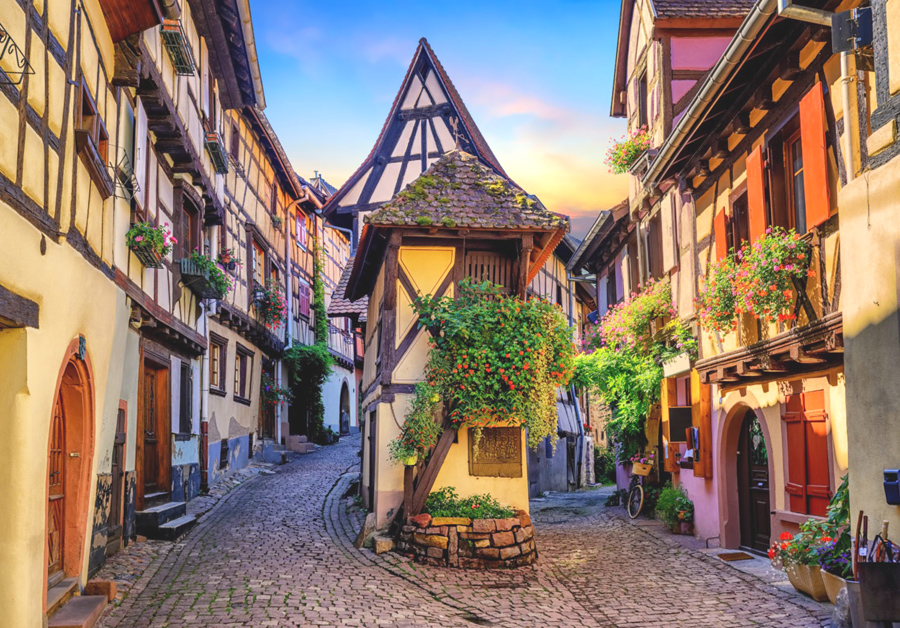
In her splendid book The Wine Bible, Karen MacNeil writes about a certain wine region that is “so charming it may as well have emerged from a fairy tale. The vineyards are sun-dappled, the half-timbered houses are cheerfully adorned with flower boxes, the 118 villages – centuries old – are immaculate.” The region is at the centre of Europe and proudly guards its traditions, language, cuisine, history and architecture. It’s most famous son was the theologian, organist, writer and humanitarian Albert Schweitzer and among its most famous daughters was Marie Tussaud, she of wax museum fame.
“And where is this region?” you may ask, if you haven’t already guessed. Well, it’s Alsace, which nestles against a back-drop of the Vosges Mountains in the north-east corner of France, right next to Germany. The two countries fought over the region for centuries and since 1681 Alsace passed between French and German control five times. The Alsatian dialect is closely related to Swiss German and the official Alsatian wine bottle, known as the Flûte d’Alsace is similar to those from the Rhine – elegant, tall and narrow with a gentle slope to the shoulders. They grow about a dozen grape varieties in the region but the two most important are the German Riesling and the Gewürztraminer. Almost all the wine produced in Alsace is white, though the region produces a tiny quantity of red in the form of Pinot Noir.
I first came across Alsatian wines in London in the 1970s when they were beginning to gain international recognition. The wines were remarkable and different to anything I had tasted before, with a distinctive but hard-to-define character that placed them apart. The Alsatian Riesling for example, has nothing in common with that from Germany or indeed anywhere else. It’s a dry, elegant yet full-flavoured wine with plenty of body and a surprising amount of fruit. The intensely concentrated Alsatian Pinot Gris has a character of its own with reminders of lime, honey and mushroom and not remotely like the simple Pinot Grigio from Italy. If you come across a bottle, give it a try. Perhaps the grape most associated with the region is the pink-skinned Gewürztraminer because in Alsace it finds its finest expression. Incidentally, Gewürztraminer with an umlaut is the German spelling and in that language, gewürz means “herb” or “spice”. Predictably, the French spell the name without the umlaut.
Alsace is the only French wine region with a tradition of labeling its wines with the name of the grape variety. Although blending is allowed, only one grape name may appear on the label. The region is the source of some of the world’s finest whites but you might be surprised to know that about half of all Alsatian wine is made by cooperatives.
Pfaff Gewurztraminer 2017 (white), France (Bt 819 + tax @ Vines to Vino)
Pfaffenheim is a commune in Alsace and this wine comes from an award-winning and well-known cooperative called La Cave des Vignerons de Pfaffenheim. I’d not tasted an Alsatian Gewurztraminer for a good many years and I was looking forward to sampling it. I was not disappointed. This wine is made from 100% Gewurztraminer and it’s a bright golden yellow. The sweet flamboyant aroma of lychee is unmistakable. Several other aromas hover shyly in the background: raisins, boiled sweets and a hint of honey. There’s also a delicate hint of rose too, often a feature of this grape. On the palate, you’ll find plenty of fruit up-front. The lychee dominates along with pineapple and citrus notes and there’s a satisfying and persistent finish. The mouth-feel has a full and remarkably silky-soft quality and the wine has a rather high alcohol content of 13.5% ABV.

The wine is described as “off-dry” which I know sounds a bit vague, but the expression has a specific meaning. Without getting too technical, it refers to the amount of grape sugar left in the wine (known as residual sugar) after the alcoholic fermentation is complete and it’s measured in grams per liter (g/l). Cream sherry for example, is about 120 g/l whereas an extra-dry sparkler could be less than 17 g/l. “Off-dry” usually refers to a wine that has between 17 and 33 g/l. The makers of this wine claim that it’s only 13.71 g/l, but to me it seems sweeter. Perhaps it’s because I normally drink whites that are as dry as the proverbial bone. However, I gave one of my unsuspecting friends a “blind” sample, and he was convinced that it was dessert wine.
Gewurztraminer is often recommended for Asian spicy dishes and I feel sure it would work well with many Thai dishes too, especially those that use ginger in the recipe. It would be perfect with distinctly-flavoured cheeses such as Roquefort, that sharp, tangy sheep’s milk blue-veined cheese from the South of France. In any event, although the wine seems sweet rather than dry, it is a charming wine and at this price remarkable value. It would make an excellent conclusion to a fine dinner. If that is, you can still afford to have them.
 |
 |
 |





